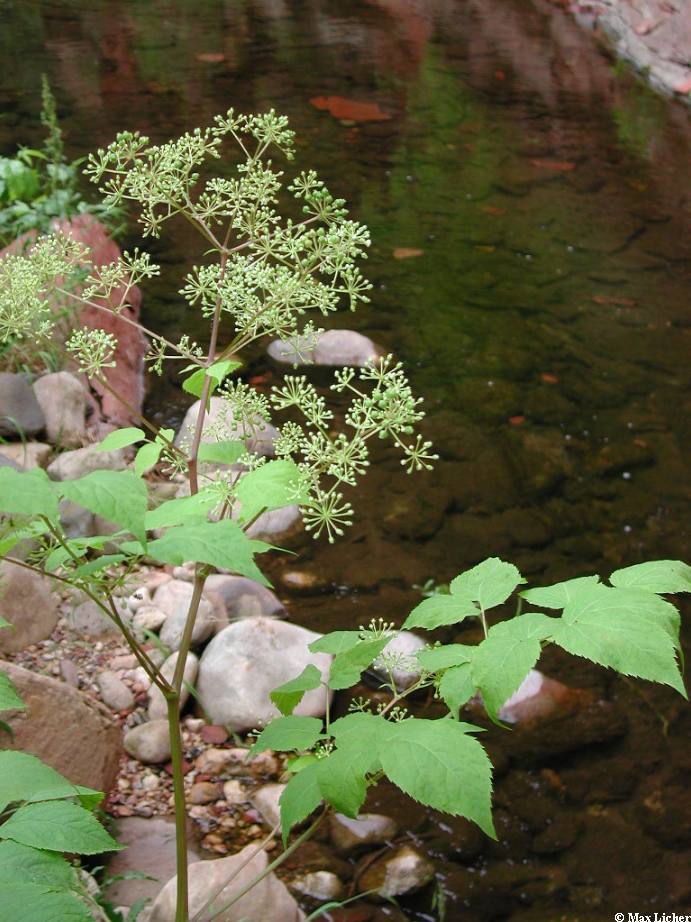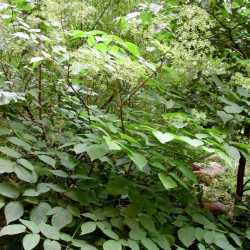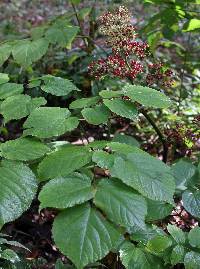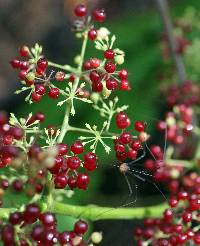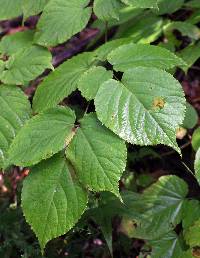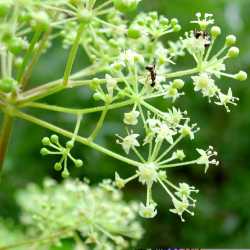|
|
|
|
Family: Araliaceae
American spikenard
|
Stout unarmed perennial herb to 2 m; lvs few, widely spreading, to 8 dm, the 3 primary divisions pinnately compound; lfls ovate, variable in size on the same lf, the larger to 15 cm, sharply and often doubly serrate, acuminate, obliquely cordate at base; infl a large panicle with numerous umbels; styles connate about half-length; fr dark purple; 2n=24. Rich woods; Que. and N.B. to Minn. and S.D., s. to N.C. and n. Mex. July. Gleason, Henry A. & Cronquist, Arthur J. 1991. Manual of vascular plants of northeastern United States and adjacent Canada. lxxv + 910 pp. ©The New York Botanical Garden. All rights reserved. Used by permission. Kearney and Peebles 1969, McDougall 1973 Duration: Perennial Nativity: Native Lifeform: Forb/Herb General: Perennial herbs, to 2 m tall, from spicy-aromatic roots; stems widely branching and without prickles. Leaves: Alternate, and petiolate, the petioles compound with 3-6 large ternate to biternate leaflets, these cordate-ovate, to 8 cm long or less, with doubly serrated margins, the ultimate divisions pinnate with 3-5, lance-ovate to broadly ovate leaflets, these doubly crenate to serrate with setose-cuspidate teeth, blades deep green, thin, and puberulent only on the veins beneath when mature, peduncles and pedicels copiously puberulent. Flowers: Small, creamy white, with 5 small triangular petals, reflexed from a rounded and raised center, stamens and stigmas white, also 5, exserted, alternate with the petals, styles 5, united, calyxes adnate to the ovary, flowers borne in racemose umbels in terminal panicles (small sprays). Fruits: Berry-like. Seeds small, several, light brown or tan. Ecology: Found in rich soils in coniferous forests, in full to partial shade, from 5,000-9,000 ft (1524-2743 m); flowering July-August. Distribution: Occurring across much of the eastern United States, found in the southwest in Arizona, Colorado, New Mexico, Utah, and Texas. Notes: This member of the Ginseng family has bright green, alternate, ovate leaves with serrated margins and small sprays of delicate white flowers, each with 5, small, cream-colored, triangluar petals reflexed from a rounded and raised center, this with small, exserted white stamens and stigmas. This species is found in Arizona in Coconino, Yavapai, Navajo, Apache, Gila, Graham, Pima, and Cochise counties according to USDA Plants. Kearney and Peebles note that the roots of A. racemosa are one of the ingredients of root beer. The other Aralia in Arizona, A. humilis, are shrubs to 2.5 m high and have simply pinnate leaves with 5-9, thickish, light green to yellowish-green leaflets that are copiously puberulent beneath and sparsely puberulent to glabrate pedicels, the older stems with rough bark. Etymology: Aralia is a latinization of an old French-Canadian or American-Indian name aralie, while racemosa means with flowers in racemes. Synonyms: None Editor: LCrumbacher2012 |


